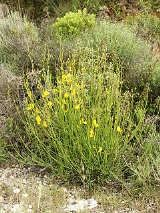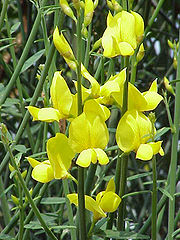
Spanish Broom
Encyclopedia
Spartium junceum known as Spanish Broom or Weaver's Broom, is a perennial, leguminous shrub
native to the Mediterranean region in southern Europe
, southwest Asia
and northwest Africa
, where it is found in sunny sites, usually on dry, sandy soils. It is the sole species in the genus Spartium, but is closely related to the other brooms
in the genera Cytisus and Genista.

grey-green rush
-like shoots with very sparse small deciduous leaves
1 to 3 centimeters long and up to 4 millimeters broad. The leaves are of minimal importance to the plant, with much of the photosynthesis
occurring in the green shoots (a water
-conserving strategy in its dry climate. The leaves fall away early. In late spring and summer it is covered in profuse fragrantyellow flower
s 1 to 2 centimeters across. In late summer, its legumes (seed
pods) mature black and reach up to 8 or 10 centimeters long. They burst open, often with an audible crack, spreading seed from the parent plant.
in places with a Mediterranean climate
such as California
and Oregon
, Hawaii
, central Chile
, southeastern Australia
, South Africa
and the Canary Islands
and Azores
. It was first introduced to California as an ornamental plant
.
and Peru
, the plant is known as retama, and has become very well established in some areas. It is one of the most common ornamental plants, often seen growing along sidewalks in La Paz
.
Retama has made its way into the ethnobotany
of the indigenous Aymara and Quechua cultures.
The plant is also used as a flavoring, and for its essential oil
, known as Genet Absolute. Its fibers have been used for cloth and it produces a yellow dye
.
Shrub
A shrub or bush is distinguished from a tree by its multiple stems and shorter height, usually under 5–6 m tall. A large number of plants may become either shrubs or trees, depending on the growing conditions they experience...
native to the Mediterranean region in southern Europe
Europe
Europe is, by convention, one of the world's seven continents. Comprising the westernmost peninsula of Eurasia, Europe is generally 'divided' from Asia to its east by the watershed divides of the Ural and Caucasus Mountains, the Ural River, the Caspian and Black Seas, and the waterways connecting...
, southwest Asia
Asia
Asia is the world's largest and most populous continent, located primarily in the eastern and northern hemispheres. It covers 8.7% of the Earth's total surface area and with approximately 3.879 billion people, it hosts 60% of the world's current human population...
and northwest Africa
Africa
Africa is the world's second largest and second most populous continent, after Asia. At about 30.2 million km² including adjacent islands, it covers 6% of the Earth's total surface area and 20.4% of the total land area...
, where it is found in sunny sites, usually on dry, sandy soils. It is the sole species in the genus Spartium, but is closely related to the other brooms
Broom (shrub)
Brooms are a group of evergreen, semi-evergreen, and deciduous shrubs in the subfamily Faboideae of the legume family Fabaceae, mainly in the three genera Chamaecytisus, Cytisus and Genista, but also in many other small genera . All genera in this group are from the tribe Genisteae...
in the genera Cytisus and Genista.

Description
Spartium junceum, Spanish Broom, typically grows to 2 to 4 meters tall, rarely to 5 meters, with main stems up to 5 centimeters thick, rarely 10. It has thick, somewhat succulentSucculent plant
Succulent plants, also known as succulents or fat plants, are water-retaining plants adapted to arid climates or soil conditions. Succulent plants store water in their leaves, stems, and also in roots...
grey-green rush
Juncus
Juncus is a genus in the plant family Juncaceae. It consists of some 200 to 300 or more species of grassy plants commonly called rushes...
-like shoots with very sparse small deciduous leaves
Leaf
A leaf is an organ of a vascular plant, as defined in botanical terms, and in particular in plant morphology. Foliage is a mass noun that refers to leaves as a feature of plants....
1 to 3 centimeters long and up to 4 millimeters broad. The leaves are of minimal importance to the plant, with much of the photosynthesis
Photosynthesis
Photosynthesis is a chemical process that converts carbon dioxide into organic compounds, especially sugars, using the energy from sunlight. Photosynthesis occurs in plants, algae, and many species of bacteria, but not in archaea. Photosynthetic organisms are called photoautotrophs, since they can...
occurring in the green shoots (a water
Water
Water is a chemical substance with the chemical formula H2O. A water molecule contains one oxygen and two hydrogen atoms connected by covalent bonds. Water is a liquid at ambient conditions, but it often co-exists on Earth with its solid state, ice, and gaseous state . Water also exists in a...
-conserving strategy in its dry climate. The leaves fall away early. In late spring and summer it is covered in profuse fragrantyellow flower
Flower
A flower, sometimes known as a bloom or blossom, is the reproductive structure found in flowering plants . The biological function of a flower is to effect reproduction, usually by providing a mechanism for the union of sperm with eggs...
s 1 to 2 centimeters across. In late summer, its legumes (seed
Seed
A seed is a small embryonic plant enclosed in a covering called the seed coat, usually with some stored food. It is the product of the ripened ovule of gymnosperm and angiosperm plants which occurs after fertilization and some growth within the mother plant...
pods) mature black and reach up to 8 or 10 centimeters long. They burst open, often with an audible crack, spreading seed from the parent plant.
Invasive species
Spartium junceum has been widely introduced into other areas, and is regarded as a noxious invasive speciesInvasive species
"Invasive species", or invasive exotics, is a nomenclature term and categorization phrase used for flora and fauna, and for specific restoration-preservation processes in native habitats, with several definitions....
in places with a Mediterranean climate
Mediterranean climate
A Mediterranean climate is the climate typical of most of the lands in the Mediterranean Basin, and is a particular variety of subtropical climate...
such as California
California
California is a state located on the West Coast of the United States. It is by far the most populous U.S. state, and the third-largest by land area...
and Oregon
Oregon
Oregon is a state in the Pacific Northwest region of the United States. It is located on the Pacific coast, with Washington to the north, California to the south, Nevada on the southeast and Idaho to the east. The Columbia and Snake rivers delineate much of Oregon's northern and eastern...
, Hawaii
Hawaii
Hawaii is the newest of the 50 U.S. states , and is the only U.S. state made up entirely of islands. It is the northernmost island group in Polynesia, occupying most of an archipelago in the central Pacific Ocean, southwest of the continental United States, southeast of Japan, and northeast of...
, central Chile
Chile
Chile ,officially the Republic of Chile , is a country in South America occupying a long, narrow coastal strip between the Andes mountains to the east and the Pacific Ocean to the west. It borders Peru to the north, Bolivia to the northeast, Argentina to the east, and the Drake Passage in the far...
, southeastern Australia
Australia
Australia , officially the Commonwealth of Australia, is a country in the Southern Hemisphere comprising the mainland of the Australian continent, the island of Tasmania, and numerous smaller islands in the Indian and Pacific Oceans. It is the world's sixth-largest country by total area...
, South Africa
South Africa
The Republic of South Africa is a country in southern Africa. Located at the southern tip of Africa, it is divided into nine provinces, with of coastline on the Atlantic and Indian oceans...
and the Canary Islands
Canary Islands
The Canary Islands , also known as the Canaries , is a Spanish archipelago located just off the northwest coast of mainland Africa, 100 km west of the border between Morocco and the Western Sahara. The Canaries are a Spanish autonomous community and an outermost region of the European Union...
and Azores
Azores
The Archipelago of the Azores is composed of nine volcanic islands situated in the middle of the North Atlantic Ocean, and is located about west from Lisbon and about east from the east coast of North America. The islands, and their economic exclusion zone, form the Autonomous Region of the...
. It was first introduced to California as an ornamental plant
Ornamental plant
Ornamental plants are plants that are grown for decorative purposes in gardens and landscape design projects, as house plants, for cut flowers and specimen display...
.
Uses
In BoliviaBolivia
Bolivia officially known as Plurinational State of Bolivia , is a landlocked country in central South America. It is the poorest country in South America...
and Peru
Peru
Peru , officially the Republic of Peru , is a country in western South America. It is bordered on the north by Ecuador and Colombia, on the east by Brazil, on the southeast by Bolivia, on the south by Chile, and on the west by the Pacific Ocean....
, the plant is known as retama, and has become very well established in some areas. It is one of the most common ornamental plants, often seen growing along sidewalks in La Paz
La Paz
Nuestra Señora de La Paz is the administrative capital of Bolivia, as well as the departmental capital of the La Paz Department, and the second largest city in the country after Santa Cruz de la Sierra...
.
Retama has made its way into the ethnobotany
Ethnobotany
Ethnobotany is the scientific study of the relationships that exist between people and plants....
of the indigenous Aymara and Quechua cultures.
The plant is also used as a flavoring, and for its essential oil
Essential oil
An essential oil is a concentrated hydrophobic liquid containing volatile aroma compounds from plants. Essential oils are also known as volatile oils, ethereal oils or aetherolea, or simply as the "oil of" the plant from which they were extracted, such as oil of clove...
, known as Genet Absolute. Its fibers have been used for cloth and it produces a yellow dye
Dye
A dye is a colored substance that has an affinity to the substrate to which it is being applied. The dye is generally applied in an aqueous solution, and requires a mordant to improve the fastness of the dye on the fiber....
.

